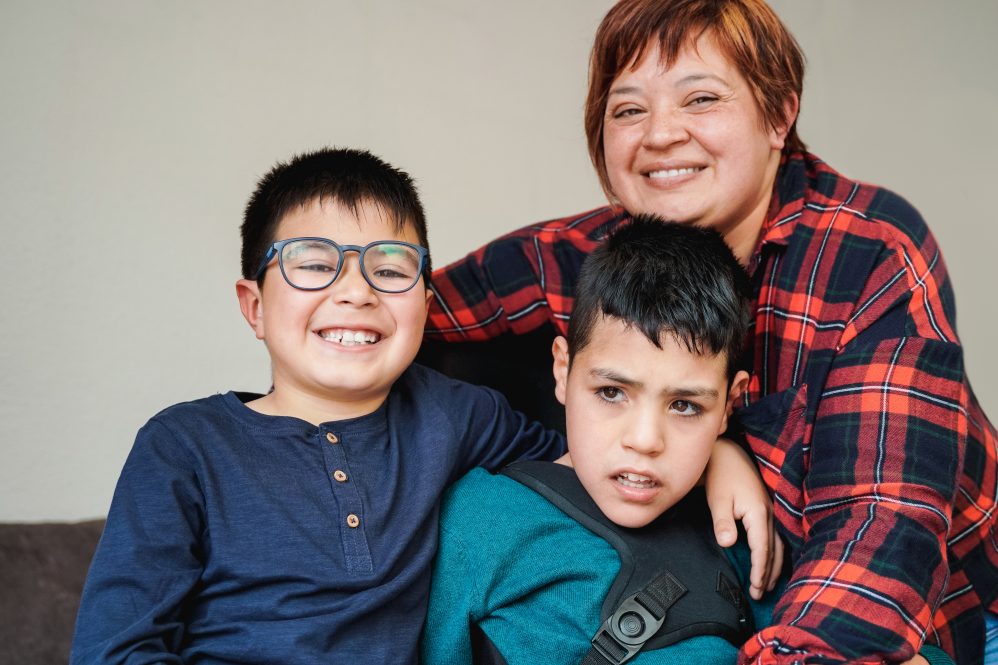Children of color and those from diverse backgrounds who have a disability are less likely to receive early intervention services than other groups, according to the U.S. Department of Education’s Office of Special Education. This inequity starts early and can contribute to developmental delays and educational disparities for young students with disabilities that persist through high school and college.
The need to improve outcomes for diverse infants and children with disabilities is a driving force behind the new Early Childhood Intervention Personnel Development Equity Center, for which UConn School of Medicine was recently awarded a $10 million federal grant. The Equity Center is part of UConn’s Center for Excellence in Developmental Disabilities Education, Research and Services (UCEDD), directed by Mary Beth Bruder, principal investigator of the Equity Center, professor of pediatrics at UConn School of Medicine, and professor of educational psychology in the Neag School of Education.
Cristina Mogro-Wilson, professor in the UConn School of Social Work and a member of the Equity Center leadership team, has long had research interests in early childhood, disabilities, and Latino families. For the next five years she will be collaborating with her colleagues at UConn, other universities, and over 40 national professional organizations to address the root causes of these inequities, including a lack of diverse early childhood professionals.
“In order to start providing more equitable services to kids and families with disabilities that come from diverse cultural backgrounds, we need a diverse workforce to meet those needs,” says Mogro-Wilson. “One of the aims of the Equity Center is to recruit and retain faculty in institutes of higher education that are from diverse backgrounds.”
Barriers to equity in early childhood intervention
As a social work educator and Latina scholar, Mogro-Wilson understands the challenges facing Latinos and other diverse families with children who have disabilities. “In Latino families, the kids are getting diagnosed later,” she says. “The later they get diagnosed or the later they receive services, there’s a lag in child development over time.”
The reasons for late diagnosis in this growing population are myriad, including long-standing structural and systemic barriers such as stigma surrounding disabilities and special education. Latino families may not be aware of the services or hesitant to access them due to their immigration status. If families from diverse backgrounds do not have their children in preschool due to cost or lack of available programs, their young children may not be identified as in need of services.
Another barrier may be lack of cultural responsiveness among providers in a field that is predominantly white. A lot of early intervention services for young children with disabilities – such as help with feeding, speech and language services, and occupational therapy – are provided in the home. Diverse families may not be comfortable with a service provider who is not from their culture, Mogro-Wilson notes.
Social workers are particularly poised in their jobs to be able to provide services to a diverse set of families. — Prof. Cristina Mogro-Wilson
Mogro-Wilson’s own research, and that of her social work doctoral students, will help inform the work of the Equity Center in addressing these access barriers. She is completing a study about how Latino cultural characteristics influence levels of stigma experienced by families who have a child with a disability, and how to mitigate the effects of such stigma on health and well-being. One outgrowth of that research is a multi-disciplinary collaboration with UConn Associate Professor of Speech, Language and Hearing Sciences Dr. Bernard Grela and doctoral student Emily Jackson to explore speech and language services for Latino families with disabilities and how to better serve these young children.
She’s also collaborating with SSW Ph.D. student Emily Longo on a grant that aims to look at the training of doctoral students interested in children with disabilities. Another one of her students, Leah Holle, recently co-authored a research paper which found that spiritual and religious beliefs were important for parents who have a child with an emotional disability. Given the stigma and stress associated with emotional disabilities, religious and spiritual beliefs and practices may be reliable and accessible resources that early childhood practitioners should be familiar with and competent in eliciting.
This broad range of research points to why Mogro-Wilson believes in having the voice of social workers at the table. “Social workers see kids that are particularly disadvantaged from high risk groups that might be experiencing trauma, neglect, and then may be also experiencing some delays and development, like autism, or delays in walking, talking, eating, or learning,” she says. “Social workers are particularly poised in their jobs to be able to provide services to a diverse set of families.”
Building a pipeline of diverse providers
To begin to address the diversity of early childhood intervention providers nationwide, the Equity Center will collect data from states. “What we’re initially doing in the beginning phases of the grant is working with our partners to collect data,” she explains. “If we want to show improvement in the diversity of our providers, we need to know what the current state is.” With this baseline data on provider diversity, the Equity Center team will focus on model states to work with to further diversify providers from a range of disciplines that serve children with disabilities.
In addition to collecting and analyzing data, the Equity Center researchers will meet with partners in state agencies to define what equity means for early childhood for diverse children and families with disabilities. “Part of our work is developing an equity framework for institutes of higher education,” Mogro-Wilson says.
With this framework, over the five-year grant period, the Equity Center’s goals include increasing the capacity of institutions of higher education to develop their early childhood programs; recruit and retain more diverse faculty; and prepare more diverse student scholars using an equity-based curriculum.
These strategies will lead to a more racially, culturally, and linguistically diverse early childhood workforce, which research shows will benefit children of color.
The institutions of higher education will also partner with state agencies to prepare diverse students and support them to enter and stay in the early childhood profession as intervention teachers, therapists, and specialists. “Ultimately that will lead to improvement of outcomes for all children with disabilities, particularly the most marginalized and underserved,” she adds.


